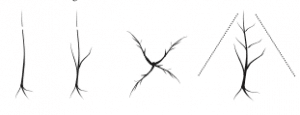Source(s):
- Lynwood Blackmon
- Ellen Bauske
Pruning and training are important practices for managing fruit trees. The primary objective of pruning and training is to develop a strong tree framework that will support fruit production. All fruit trees are not pruned and/or trained in the same fashion. This publication is designed to get a new tree started correctly and will cover pruning and training in the first year only. It is not comprehensive. Visit UGA Cooperative Extension’s web site (http://www. caes.uga.edu/Publications/subjectList.cfm) and find the publication on your specific tree. For example, search home garden figs, apples, blueberries etc. These publications contain up-to-date, research-based information.
The proper time to prune is during late winter and early spring before new growth occurs. During this time, pruning wounds heal quickly, flower buds and undesirable branches are easily recognized, bark is less likely to tear when cuts are made, and injury from low winter temperatures is avoided. Light summer pruning may also be used to train young trees to the desired shape, improve light quality, thin fruit loads or remove water sprouts and other undesirable growth.
Apple, Pear, Plum and Apricot
These trees are pruned and trained to a central leader. A central leader tree is characterized by one main, upright trunk, referred to as the leader. Branching generally begins on the leader 24 to 36 inches above the soil surface to allow movement under the tree.
Whether you obtain a small, unbranched whip or a larger, branched tree, it is necessary to prune the tree at planting. Cut the unbranched whip back to 24 to 30 inches from the ground. This will cause the buds just below the cut to grow and form scaffold branches. If branched one or two-year-old trees are planted, select four or five lateral branches with wide-angled crotches and that are spaced equally around the tree and 2 to 5 inches apart vertically. The selected laterals should be no lower than 18 inches above the ground, and they should be pruned back slightly by cutting off 1/4 of each limb’s length.
Figs
Begin training to bush form at the time of planting by cutting off one-third of the young plant to force shoots to grow from the base of the plant. Allow these shoots to grow throughout the first season.
Pomegranates
Cut trees back to 2 to 2.5 feet at planting and allow 5 to 6 vigorous suckers, evenly distributed around the stem to develop. Since the fruits are borne only at the tips of new growth, judiciously shorten the branches to encourage the maximum number of new shoots on all sides, prevent straggly development, and achieve a strong well-framed plant.
Blackberries and Raspberries
Blackberries and raspberries are biennial fruiting plants that may be trellised. They produce little or no fruit the first year. Little pruning is needed for blackberries and raspberries the first year.
Blueberries
The general rule is to remove 1/3 to 1/2 of the top of young blueberry plants when transplanting them to the field. Remove weak, twiggy growth near the base of the plant and side branches bearing flower buds. Remove flower buds the first and second year after planting to stimulate vigorous growth. Failure to remove flower buds from young plants can reduce canopy growth and delay plant establishment.
Muscadines
A Muscadine grape plant consists of a trunk and selected side shoots referred to as cordons. The cordons are spread out and attached to the trellis support wires. Pruning initiates growth of short lateral shoots called spurs that come directly off the cordons. The new fruit develops on these spurs. All shoot growth from last summer should be cut back so that spurs will all have from 2 to 4 buds each. Prune along each of the cordons or main side branches to eliminate excess competition. Cut off excess growth so that there is at least a 6 inch spacing between each of the spurs.
Resource(s):
Simple Tree Training Techniques for Peaches
Center Publication Number: 258
- Pruning and Training New Fruit Trees - September 23, 2013

This is some really good information about pruning fruit trees. I have been thinking about getting a few plum trees this year. It is good to know that I should prune the branches 1/4 of the length of the limb.